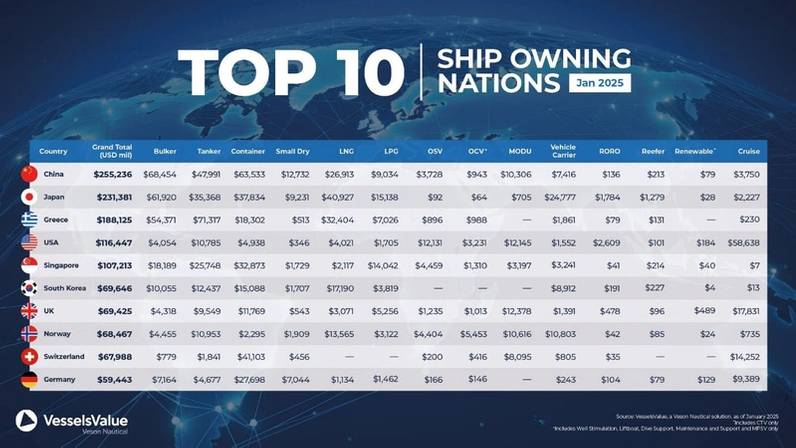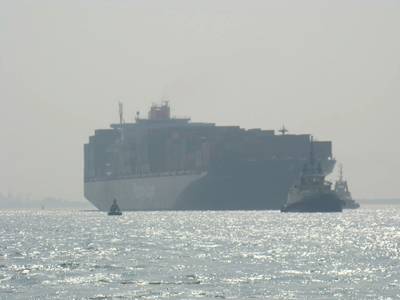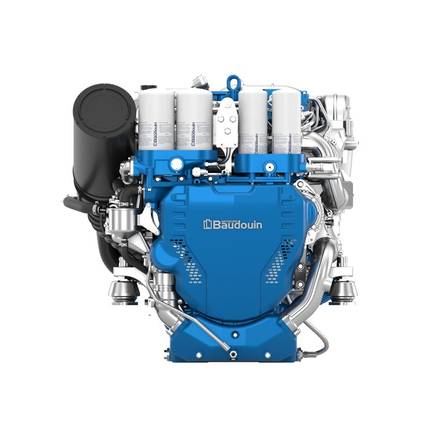Ranking & Reporting the World's Top 10 Vessel Owning Nations
In the ever-evolving world of maritime trade, ship ownership is a key indicator of economic influence and global commerce. As we enter 2025, Veson Nautical offers its Top 10 Ship Owning Nations, offering a detailed analysis of fleet values and industry shifts. This year, China has surged to the top, overtaking Japan in total fleet value, while geopolitical events and shifting market dynamics continue to shape the rankings.
Let’s take a closer look at the global giants of ship ownership and the forces driving their dominance.
1. China: The New Maritime Powerhouse
For years, China has held the title for the largest fleet in terms of vessel numbers, but now it has also become the world’s most valuable fleet owner, surpassing Japan with a staggering $255 billion in total fleet value. China's dominance is fueled by its Bulker and Container sectors, valued at $68.4 billion and $63.5 billion, respectively. The surge in vessel values is largely due to disruptions in the Red Sea and increased ton-mile demand, as ships reroute around the Cape of Good Hope to avoid hostilities. China’s rise is a reflection of its aggressive investments in shipbuilding, expansion into global trade routes, and its growing influence in maritime logistics.
- Bulker Values on the Rise: 20-year-old Capesize vessels (180,000 DWT) have appreciated 26.98% over the past year.
- Container Boom: 20-year-old Handy Containers (1,750 TEU) saw an unprecedented 171.86% value increase.
- Tankers Lead in Numbers: With 1,764 vessels, China has the largest tanker fleet, worth $47.9 billion.
2. Japan: A Strong Contender Despite Losing the Top Spot
Japan, now in second place, still commands a $231.3 billion fleet, marking a 12% growth from 2024. While China has overtaken it, Japan remains a dominant player, particularly in specialized vessel markets.
- Largest LNG Fleet: Worth $40.9 billion
- Leading in LPG & Reefers: LPG fleet valued at $15.1 billion, Reefers at $1.3 billion
- Stronghold in Vehicle Carriers: Holding a $24.8 billion stake
- Bulk carrier values peaked in October 2024, with 20-year-old Capesizes hitting $20.32 million, reinforcing Japan’s commitment to high-value ship assets.
3. Greece: The Tanker Powerhouse
Greece remains in third place, consistently ranking among the world’s top maritime nations. While China holds more tankers in sheer numbers, Greece’s tanker fleet value is higher, standing at $71.3 billion—a remarkable $23.3 billion above China’s.
Greece’s strength lies in its strategic positioning in global shipping lanes and its ability to capitalize on geopolitical shifts, including Russian sanctions and Red Sea conflicts, which have boosted ton-mile demand.
- Tanker Market Boom: 10-year-old LR1 tankers (75,000 DWT) hit a 15-year high, rising 14.58% year-on-year.
- Second Largest LNG Fleet: 143 vessels, worth $32.4 billion
4. United States: The Reigning Cruise Giant
The U.S. holds its fourth place ranking with a $116.4 billion fleet, marking a $16.5 billion increase from 2024. With Carnival and Royal Caribbean headquartered in the U.S., the nation continues to dominate the cruise sector. Fleet values have surged by nearly $10 billion, reflecting growing demand for luxury ocean travel.
- Undisputed Cruise Leader: The U.S. boasts the largest cruise fleet globally, valued at $58.6 billion.
- Top RoRo Fleet by Value: $2.6 billion worth of vessels, though it lags behind Japan and Turkey in fleet size.
 Courtesy Veson Nautical
Courtesy Veson Nautical
5. Singapore: A Rising Power in LPG and Offshore Support
Singapore remains fifth, boasting a $107.2 billion fleet, a $21 billion rise from last year. A strong LPG market has significantly boosted asset values, increasing by 50.5% year-on-year. Singapore’s strategic location and advanced port infrastructure continue to make it a major maritime hub.
- Second Largest LPG Fleet: Valued at $14 billion
- Dominant in OSVs: Offshore Support Vessels (OSVs) worth $4.4 billion
6. South Korea: Strength in LNG and Vehicle Carriers
Holding firm at sixth place, South Korea’s $69.6 billion fleet has grown by $2 billion over the past year. While it remains outside the top 10 in terms of vessel count, South Korea’s investments in high-value ships keep it competitive.
- Fourth Largest LNG Fleet: Valued at $17.2 billion
- Key Car Exporter: Continued investments in vehicle carriers, including six new LCTC vessels set for delivery by 2028.
7. United Kingdom: Surging Tanker and Container Values
The UK has climbed to seventh place, despite not ranking in the top 10 for vessel numbers. Strategic investments in LPG and Containers have reinforced the UK’s standing in the global market.
- Cruise Sector Dominates: Making up 25% of the total UK fleet value.
- Tanker Fleet Growth: Values increased by 32% to $9.5 billion.
8. Norway: A Gas-Driven Fleet Expansion
Norway has dropped to eighth, with a fleet worth $68.5 billion, still up by $10 billion from last year. Norway’s investments in LNG and LPG position it as a key player in the future of clean energy shipping.
- LNG Fleet Growth: Now worth $13.6 billion, making up 20% of Norway’s fleet.
- Vehicle Carriers on the Rise: Worth $10.8 billion, marking a $1 billion increase.
9. Switzerland: Back in the Game
Switzerland reenters the top 10 with a $68 billion fleet, largely due to container sector growth and MSC’s continued expansion. With MSC leading the charge, Switzerland is reinforcing its role as a major container powerhouse.
- MSC’s Influence: In 2024 alone, MSC added 63 second-hand vessels and placed 64 new orders for delivery between 2026-2029.
10. Germany: A Declining Position, But a Rising Fleet Value
Germany drops to tenth place, continuing its downward trend. However, its fleet value has increased by 55.6% year-on-year to $27.7 billion. Germany’s historical dominance in containers is still evident, but its position in the global rankings has weakened as other nations expand aggressively.
- Container Fleet Strength: Germany holds the second largest container fleet in numbers, despite dropping in rankings.
Final Thoughts: The Future of Global Ship Ownership
As 2025 unfolds, China’s ascendancy to the top reflects a new era of ship ownership, fueled by geopolitical shifts, energy transitions, and expanding trade routes. Japan, Greece, and the U.S. continue to hold their ground, while emerging investment trends in LNG, LPG, and offshore shipping are reshaping the rankings. With demand for energy-efficient, high-capacity vessels soaring, the race for maritime dominance is far from over. Who will lead the industry in the next decade? Only time—and trade winds—will tell.
Source: Veson Nautical + Staff














